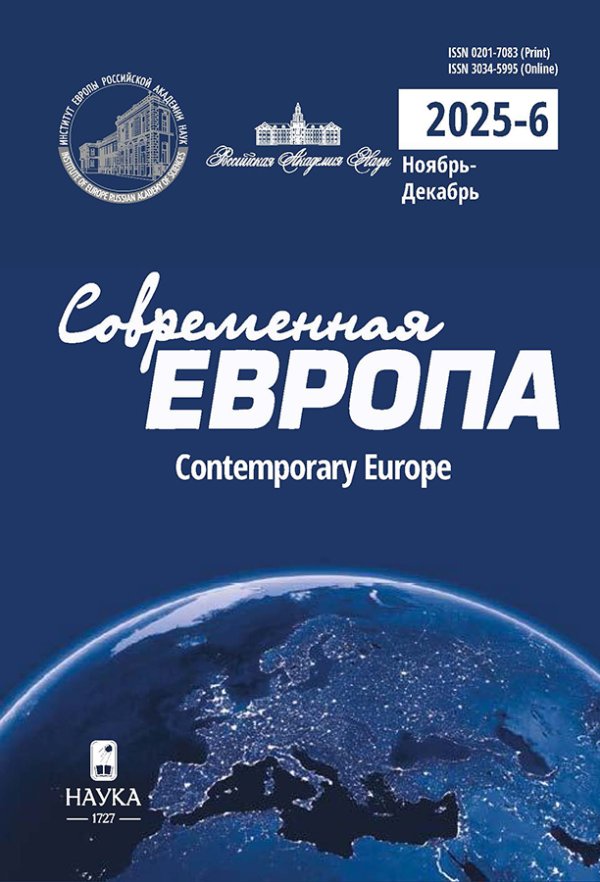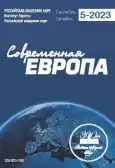International labor migration policy of the European Union
- Authors: Revenko N.S.1
-
Affiliations:
- Financial University under the Government of the Russian Federation
- Issue: No 5 (119) (2023)
- Pages: 105-118
- Section: Articles
- URL: https://journals.rcsi.science/0201-7083/article/view/142231
- DOI: https://doi.org/10.31857/S0201708323050091
- EDN: https://elibrary.ru/XYTXEX
- ID: 142231
Cite item
Full Text
Abstract
About the authors
Nikolai Sergeevich Revenko
Financial University under the Government of the Russian Federation
Email: reni100@yandex.ru
Moscow, Russia
References
- Биссон Л.С. (2020) Регулирование легальной миграции в Европейском союзе. ИЕ РАН, Москва. 150 с. doi: 10.15211/report42020_371
- Журбина Н.Е. (2018) Политические проблемы урегулирования трудовой миграции в Европе. Вопросы политологии. № 8(36). С. 460-470.
- Мартиросян Д.Г. (2022) Регулирование легальной трудовой миграции из третьих стран в соответствии с законодательством Европейского союза. Научное обозрение. Серия 1: экономика и право. № 1. С. 121-131. doi: 10.26653/2076-4650-2022-1-09
- Пасякина Л. (2011) ЕС и трудовая миграция. Современная Европа. № 3 (47). С. 92-105.
- Потемкина О.Ю. (2020а) Европейский союз: сезонные рабочие в условиях пандемии. Научно-аналитический вестник Института Европы РАН. № 5(17). С. 45-51. doi: 10.15211/vestnikieran520204551
- Потемкина О.Ю. (2020b) Многоуровневое управление миграцией в Европейском союзе. Современная Европа. № 2. С. 100-110. doi: 10.15211/soveurope22020100110
- Семеко Г.В. (2021) Трудовая миграция в Европейском союзе в условиях кризиса COVID-19. Экономические и социальные проблемы России. № 4(48). С. 110-128. doi: 10.31249/espr/2021.04.06
- Caldarini C. (2022) Atypical work and the social protection of migrants in Europe. FEPS, Brussels, Belgium. 35 p.
- Chaloff J. (2016) The Impact of EU Directives on the labour migration framework in EU countries. OECD Social, Employment and Migration Working Papers 180. OECD Publishing, Paris, France. 86 p. doi: 10.1787/5jlwxbzpwh33-en
- De Lange T. (2019) A ‘Guildian' Analysis of The Equivocal Trusted Sponsorship under EU Labour Migration Law. Caught In Between Borders: Citizens, Migrants and Humans. Ed. by P.E. Minderhoud, S.A. Mantu, K.M. Zwaan. Wolf Legal Publishers, Tilburg, Netherlands. P. 209-216.
- De Lange T., Vankova Z. (2022) The Recast EU Blue Card Directive: Towards a Level Playing Field to Attract Highly Qualified Migrant Talent to Work in the EU? European Journal of Migration and Law. No. 24. P. 489-515. doi: 10.1163/15718166-12340138
- Dorn D., Zweimuller J. (2021) Migration and Labor Market Integration in Europe. Journal of Economic Perspectives. Vol. 35. No. 2. P. 49-76. doi: 10.1257/jep.35.2.49
- European Parliament (2021) Legal Migration Policy and Law. European Parliament Research Service, Brussels, Belgium. 98 p. doi: 10.2861/912905
- Farcy J-B. (2020) Labour Immigration Policy in the European Union: How to Overcome the Tension between Further Europeanisation and the Protection of National Interests? European Journal of Migration and Law. No. 22. P. 198-223. doi: 10.1163/15718166-12340074
- Fudge J., Olsson P.H. (2014) The EU Seasonal Workers Directive: When Immigration Controls Meet Labour Rights. European Journal of Migration and Law. No. 16. P. 439-466.
- Kolb H. (2017) From Brakeman to Booster: Policy change.International Migration. Vol. 55. Issue S1. P. 11-21. doi: 10.1111/imig.12368
- Laubenthal B. (2017) Introduction: Labour Migration in Europe: Changing Policies - Changing Organizations - Changing People.International Migration. Vol. 55 (S1). P. 3-10. doi: 10.1111/imig.12408
- Lavenex S. (2006) Shifting Up and Out: The Foreign Policy of European Immigration Control. West European Politics. Vol. 29. No. 2. P. 329-350.
- Minderhoud P. (2021) Regulation of EU labour migration: At a crossroads after the new Pact on Migration and Asylum. Utrecht Law Review. Vol. 17 (4). Special Issue: Mobility in a European Post-Crisis Scenario: Regulatory Dynamics and Enforcement Challenges. P. 31-44. doi: 10.36633/ulr.749.
- Oguz G. (2020) Labour Migration in the European Union. Palgrave Macmillan, Cham, Switzerland. 264 p. doi: 10.1007/978-3-030-36185-3_3
- Schmid-Druner M. (2020) New avenues for legal and labour migration. European Parliament, Brussels, Belgium. 29 p.
- Thym D., Hailbronner K. (ed.) (2022) EU Immigration and Asylum Law: Article-by-Article Commentary. Verlag C.H. Beck oHG, Munchen, Germany. 1806 p.
Supplementary files










